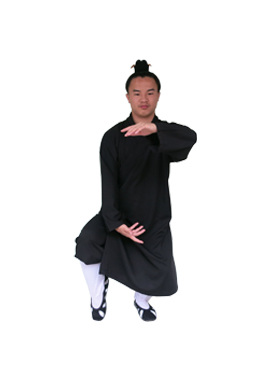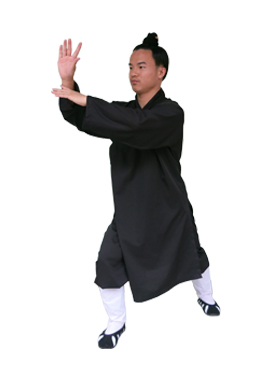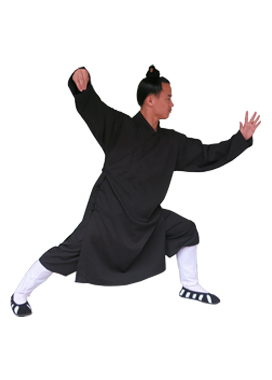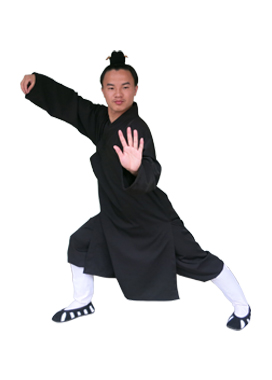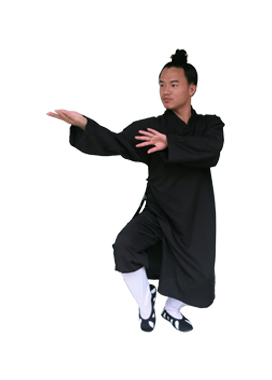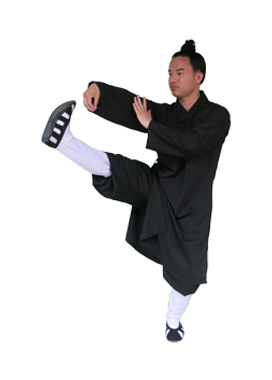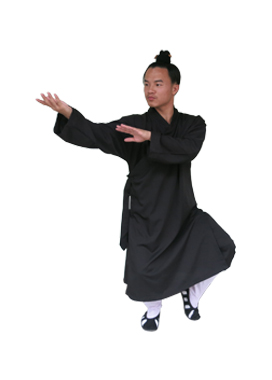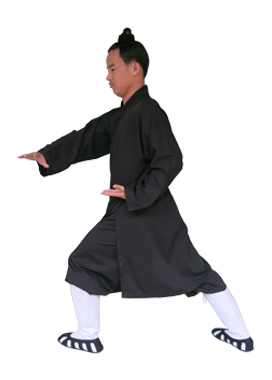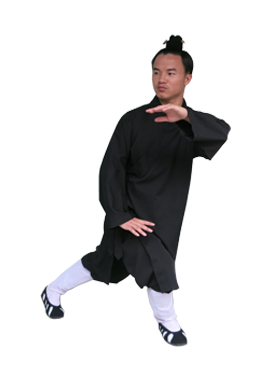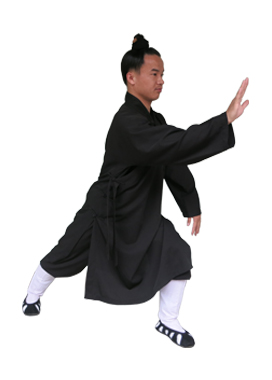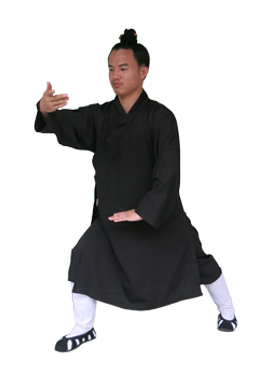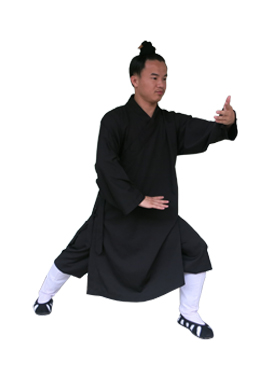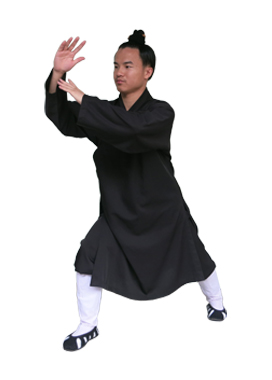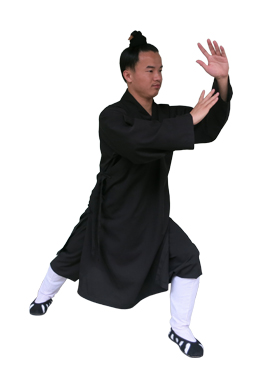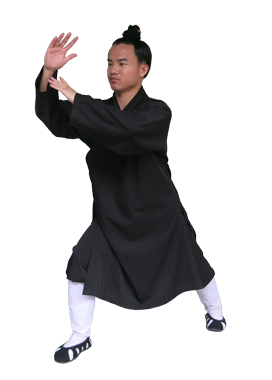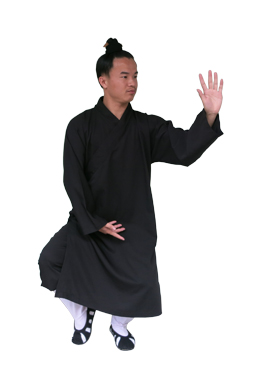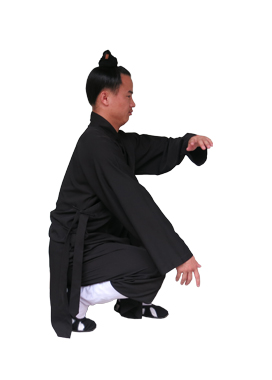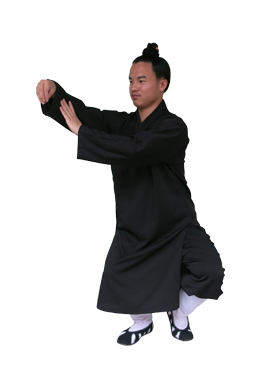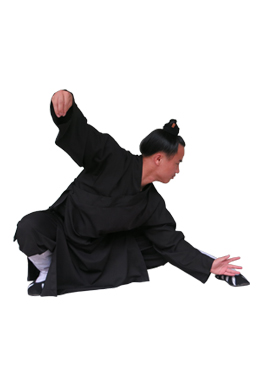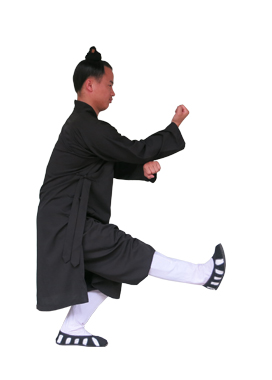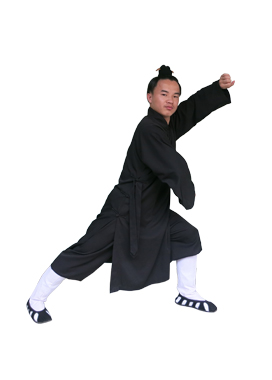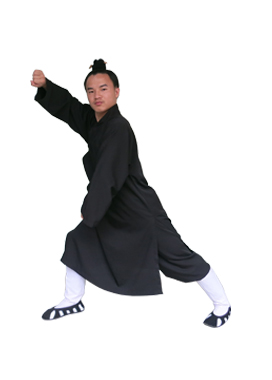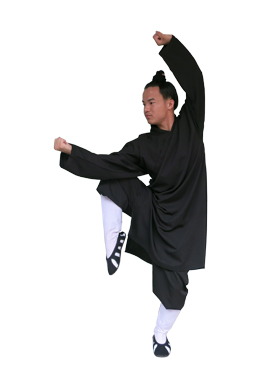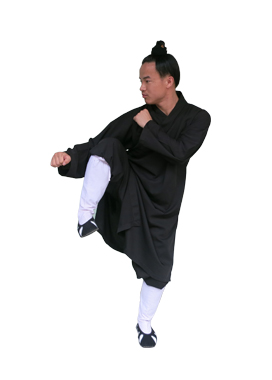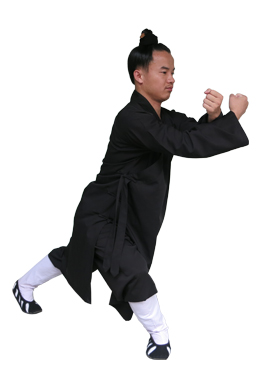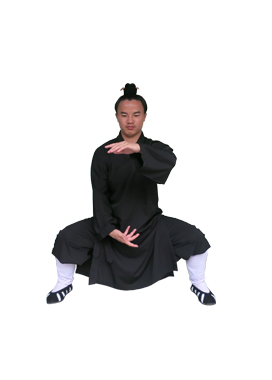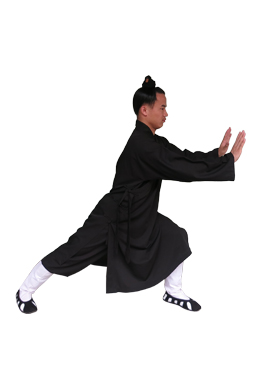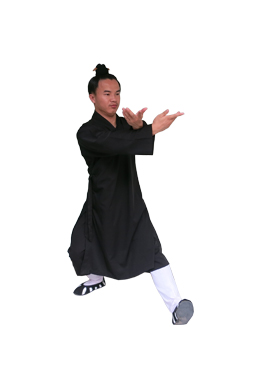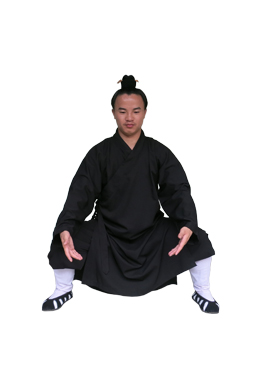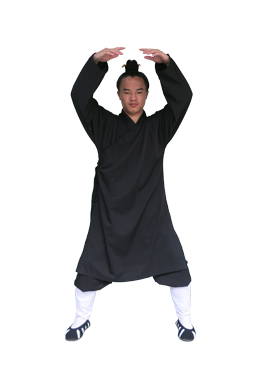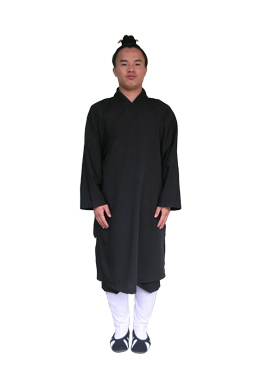武当三丰太极十八式 Wudang Sanfeng Style Taiji 18 Forms
|
|
武当三丰太极拳十八式拳谱动作分解: 01、预备式 02、起式 03、退步崩式 04、顺拉单鞭 05、提手上式 06、搂膝拗步 07、野马分鬃 08、玉女穿梭 09、云手单鞭 10、单鞭下式 11、上步七星 12、退步跨虎 13、独立格挡 14、进步搬捶 15、如封似闭 16、十字化手 17、抱虎归山 18、收式 1. Preparatory form 2. Opening form 3. Step back warding form 4. Pulling along the single whip 5. Lift hands & step forward 6. Left brush knee twisting step 7. Part the wild horse’s mane 8. Jade maiden works the shuttle 9. Cloud hands single whip 10. Low single whip form 11. Step forward to seven stars 12. Step back & straddle the tiger 13. Blocking parry on one leg 14. Step forward, parry & hammer 15. Withdraw & push 16. Cross hands 17. Carry the tiger & return to the mountain 18. Closing form
第一式:预备式 姿势:面南直立,自然中正,全身放松,两眼平视,头正直,项松竖,头顶虚灵,仿佛上顶有线悬梁之意;下颔微收,齿轻合,唇轻闭,内舌轻触上腭;两臂坠肘下垂,沉肩松胸,气含小腹,肘不贴肋,手心向里,中指肚轻贴腿侧(裤缝);松胯,两膝微弯,分脚,两脚与肩同宽,脚尖朝前,十趾随意动而抓地;呼吸顺遂平畅,意守丹田。 要点:头顶悬意不可缺,长腰松胯,护肋,胸间不凹不凸背要圆,十趾抓地空涌泉穴。 说明: ①此预备式乃无极式,其基本要领均体现太极拳贯串始终的各项要求,故在行拳过程中均应一贯持守这些法则; ②此无极式暂未分阴阳虚实,但重在呼吸自然,意守丹田,虽静犹动,势如张弓待发之动意,守我之静,待人之动; ③思想集中而虚静无物,神气抱一而达无形无象之感,然意存丹田而待动,保持一种平和静气,安祥随和,全神贯注而内敛一种神气之韵 动作:双手托天 气沉丹田 1.双手捧天 两臂分别从两侧,意动、手动、腕、肘整体一起向上缓慢抬起,沿斜前方起手(与身体成1 5 o~45。夹角) 起手与肩平沉肩坠肘,撘腕,此时是吸气和意念吸收地之灵气之势和灵气向上运行之中,手指领意,劳宫吸天之精华,捧天之精华之气,又转腕向内,手向上抬至头顶百会穴。此时是吸气和意念吸收地之灵气之势和灵气向上运行之中,手指领意,劳宫吸天之精华,手臂从裤缝侧上行时,捧天之精华之气,当到达头顶时,又转腕向内,掌心遂变朝下,十指相对,意念天地之精灵汇聚百会穴(图2)o 2.气沉丹田 接上动作(在十指相对掌心朝下时),沿体前前臂以抱球状下行,做不明显呼气,意念百会真气下行人中穴,达鹊桥,沿任脉、经天突、璇玑、华盖、膻中、中脘、神阙,聚回丹田。双手亦同达下腹,后分别沿带脉斜下胯边,回至无极式 要点: ①这是一个深呼吸过程,意念周天循环,呼吸要彻底,手意牵引要协调,吸尽天地灵气,真气存聚丹田。 ②这也是开始进入功态的一个起势,保持全身放松,心情平和舒畅动作慢,匀称一致,呼吸在自然之原则下,由师傅和自己的熟练程度而掌握方式。 说明:掌经云:“先在心,后在身。”修道即修心,故首先要心无杂念,开始练此功也须遵循“有为”地存想内观之法。此运行大周天之功是,先扣脚十趾而提涌泉吸地之灵气,实质一是稳定脚根,二是活动经脉,沿阴跷上行缩阴提肛,过三关到达百会。此时两手劳宫及天门九宫打开吸收天之精华而聚汇百会,再由百会沿任脉下到丹田,此中真气保存,鼓腹蓄气,废秽之气随放松之体散发体外。 这一过程意念可强可弱,不可过僵过执,动作要慢,意念、动作、呼吸三合一,要协调。所以预备式的气势就影响和决定整个行拳的效果,需下功夫练习。 1. Preparatory form 预备式 Posture: Face south, stand upright and relax the body. Look straight ahead with chin pointing slightly upward. Retract the lower jaw, bite softly, and loosely close the lips. Bring the tongue to the hard palate. Place the arms at the sides of the body with both palms facing inward and sink the shoulders. The elbows should not touch the ribs, but the middle fingers should gently brush the seam of the trousers. Stand with feet at shoulder width apart with toes pointing forward. Relax the pelvic and slightly bend both knees. Inhale to lower abdomen and regulate breath. Key points: Stand upright as though hung by a string from above. Keep sides of the body long and pelvic relaxed. Slightly round the shoulders without hollowing or puffing the chest. Grip the ground with ten toes and hold two hollows at Yongquan point. Explanation: i) This is a Wuji-style preparatory form. Its basic essentials reflect various requirements of Taiji Quan that should always be observed during the practice of the 18 forms. ii) Wuji-style does not yet differentiate between yin and yang, or virtual and real. It focuses instead on breathing. Although the form is still, it prepares for movement like an arrow on the bowstring. iii) During the preparatory form, thoughts are focused and breath is regulated. Movements: a) Two hands hold up the Heavens: Raise both arms slowly diagonally upwards at 15 to 45 degrees from the body to shoulder level. Sink the shoulders, lower the elbows, and flip both palms facing front. While inhaling, turn wrists inward at 90 degrees, and raise both arms to Baihui point. b) Sink the breath to lower abdomen: While exhaling, flip palms downward and lower the arms in front of the body, as though holding a ball. Rest both hands at lower abdomen and slide hands down towards the sides of the crotch. Key points: i) These are deep breathing movements designed to circulate the breath. The hands are moved in a way to help regulate breath. ii) These movements are essential to prepare the body for the opening form. The body is relaxed, mood is gentle, movement is slow, and breath is uniform throughout. Explanation: Grip the ground with ten toes and hold two hollows at Yongquan point to stabilize the feet and activate the meridians. Regulate Qi upwards to Baihui point. Acknowledge random thoughts and let it go. Movements should be slow. Thoughts, movement, and breath should be uniform. Preparatory form is important in preparing for the following forms. Students should practice to make this form perfect. |
|
|
第二式:起式 动作:1、提手上式 2、虚步下切 1.提手上式 两臂分别内动,向上搠起,手心由相对变为向下,上棚同时胯膝下坐,成马步,气在丹田,慢慢屈膝成115℃屈膝度根据架式高、中、低而定,通常以中架为例,以下均同中架)。搠至臂与肩平,要意达指梢而微微坐腕,手变勾手, 2.虚步下切 接上动做,重心在左脚,坐胯右脚变虚,脚尖着地,同时右勾手顺左手腕下切,在转移重心到右边,同时左手顺右手完下切至右边,45度角至膝下足三里侧,屈臂沉肘格架在与肩平。 要点: 1.遵循拳经“一动无有不动”原则,全身首先在放松的前提下,用意不用力地开始柔和运转,轻灵与沉着俱在,变换虚实,注意上下,一动就开始体现阴阳。 2.行拳中腰身、手、腕、肘、胯、膝均活而不僵,活而不乱,松而不懈,刚而不僵,以意引动有规则转动,身体似屈非屈,似直非直,动作到位,意气也一定到位。 3.一般按呼吸自然原则,多以起时吸,承(沉)时呼,即上吸下呼,但均不明显用口鼻,行拳保持匀、细,因其动作缓慢而又深长,所以一般开始学拳架动作,不必过分注意呼吸方式。时时注意气沉丹田而意于腰腹,活于胯部。 用法: 因为太极拳因人而动,因敌而变,所以在一个招法中可因对方的用力和攻击方式而采取几种不同的攻防方式,故此,在介绍其用法时,一般只突出一例,其余稍加说明或省略。 太极拳起势在用法上,须符合贵化不贵抗,后发先至的思想,化中有打,打中有化。 “双搠撑掌”主要是应付对方“双风贯耳"或“双按推掌"。对方欲出双拳击打头部,我则坐身,使对方落空,同时出双掌对对方胸前的空处推掌。如果对方双按掌来,我搠撑相接,粘上而随力化走,根据对方变招而再出招还击。多数方式以脚下虚实变换,手法一防一攻而立判胜负。 “虚步下切"中含有几种变化方式,据敌而用,而用时之势,已不再像虚步下切之定势了。 2. Opening form起式
|
|
|
第三式:退步崩式 动作:1、丁步抱球 2、转身架掌 1.抱球独立 接上式。重心移至右脚,右手与左手由勾手变掌成包球式,脚成丁字步,右45度角。身体保持正中,背直不屈,两掌心相对,右腿微屈 2.转身架掌 接上动。由腰转带动左腿向后(东北),左脚向前落地,脚跟先着地,成左前进步;左手随身体由下朝上划弧搠起,掌心朝里,右掌由眼下经胸前向左腋下推出,横掌式,掌心向外内定型时,手、脚、身、步一起到位 要点: 1.正如介绍武当三丰太极拳特点时说过:此拳步法灵活,仅从开始几动中可以看出步、腿的灵活度,同时要求步、身、手,齐到合一。 2.动作连贯性不可分割、断劲,在定型时,微有内劲到达之意,非单操练时,不得用力或发力。 3.此拳架攻防意义很强,虽练时不专注攻防作用,但要明细其用法。此转身上步、上搠下打之法,动作显明,同时可变作左揽雀尾式的用法,惟方向相反,用法不另叙。 3. Step back warding form退步崩式 Movements: a) Hold the ball standing on one leg: Shift weight to the right leg, and convert hook hands into hold-the-ball hands. Stand in T-stance, with right foot angled at 45 degrees. Stand straight up with flat back, palms facing each other, and right knee slightly bent. b) Rotate the body and lift palms over head: Twist the waist and swing the left leg backward. Bring the left leg forward and land on the heel. Raise left arm in a curved movement, with palm facing inward. Lower right palm towards the chest and push right palm out under the left underarm. Key points: i) This form maintains agility in the footwork and unison in feet, body and hand. ii) The movements are coherent and inseparable. When not exercising along, no force should be applied. iii) This form is designed for defense and attack. It can be converted to Pulling the Peacock’s Tail form readily. |
|
|
第四式:顺拉单鞭 动作 1、平撩上架 接上式。右掌按朝上微翻,向右上方45度,成分式,随身体带回后脚方位,右手臂与左手臂成圆,右掌心向上,分时之意,随身向左移,重心在左脚,左脚以后跟为轴随手臂向右上方45度转,重心在右脚,右脚后跟不动,前脚掌内扣,与手臂同方向,坐胯,右手由仰掌变插掌,左掌变托掌,右手在左手上,向下压同时下蹲,左转180度,右手从左臂内侧上穿,起身。 右手在左臂横画转回原位,右手在太阳穴成勾手式,左手护右腕,左腿侧面提起蹬出. 2、顺拉单鞭 左脚收回向左跨步,成马步式,左手由右侧反掌到左侧太阳穴处,(手掌切勿过膝盖)反掌同时马步变弓步,右手不边成勾手(这一连串动做要一气合成) 要点: ①在左右平带过程中,拧劲等暗劲是关键,要求也很严格。 ②像两掌二方向相对,意为把持手和肘,时时可采捌制住对方,往返之变是根据对方力的变化而变化,折叠过程中的身、腰、脚均要一致变化,体现整体性,才能制敌。 ③插撩之变,即为变化无方之意,根据对方空处、破绽处而击,上架十字手,下出进腿,落步而顺掌到,动作是圆而连贯,有一定的实用价值。 用法:单鞭之用,变化多端,丰富多彩,每一个动作是一个技击用法的母式,这一母式本身可以发劲击人外,还可演化出多种招式o ①动作之左右平带,就是若对方朝我中上部一拳击来,我一手粘拳头、一手托臂肘,运用听劲掌握对方力向,既可采捌拿脉、反骨,也可把架肘靠而放出对方。 ②若对方力大,肯定会反抗我之力,我则顺其力变成拧履而击空胁。 , ③若对方中胁击不成,则上击咽喉,架肘击裆腿,乘机进步而放发。关键是手脚进肘,身腰要捅跟而上,有一种捅挤之势。
|
|
|
第五式:提手上式 动作:1、弓步推掌 2、上步插提式 3、落地按封 1.弓步推掌 接上式。重心右移,左脚尖回扣,变马步,左手从腰间推掌,左脚和左手同时动,边成成步推掌,右手不动、 2.上步插提式 身体重心移在左脚,右手与左手同时在身体左侧画圆,重心在左脚右脚平蹬出,在同一时间右手勾手。左手边掌护右肘,与右脚一起随身上提,与肩平,成勾提手式。 3.落步按封 接上那个面动作,脚回收下落,腰身带动右胯,腿与手、臂一起下落成右后方马步,左手随身化收回腰间,右手随落而按切在裆前,掌心向内,形成马步切掌式 要点: ①经云:粘即是走,走即是粘。单鞭之后的左手对来敌之变,就是粘化之法,粘后护面,侧身上法,护身打下,随化随进,其妙法也o ②提手之式,即右手勾与右脚尖,有一根线带着之意,连呼吸一起同动,落步按封时,呼气。 ③身法要协调,稳固,沉肩松肘,意在腰际,带动全身。 用法:左手对敌之攻势,先粘化,或格粘或化拿,随后护面进身,偷步旋转步法,委身击敌下部,若不中,可随之蹬裆,踢腿,落步按封。主要对付来势汹涌之拳脚,沉气切按。
|
|
|
第六式:搂膝拗步 动作:1、撩掌式 3、搂膝拗步
1、撩掌式 右手从身体侧边起与肩平,左手向下压,至右手肘关节,重心在右脚成丁字步。 说明:这是一个过渡动作,但实用价值颇高。当白鹤亮翅之势时,自己中胸空虚,对方会趁虚而人,我则随急而用手拂面而下,俗称“猫洗脸”,把对方击至我面前的掌脚轻拂过去并粘上之后,随机变出下一招式的击法。
2、搂膝拗步 重心在右腿,左脚提起,向左前方45度,呈弧形迈出;左手同时翻掌,拂过右腿膝盖处,置于膝左侧;左脚先以脚跟着地,随着重心渐移而左脚踏实,承受重力,成左弓步;右手随身体重心前移和腰身左转而手指在前,经右肩前呈弧形推出。 要点: ①两手的弧形拂划必须随腰身同动,腰、胯的转动要稳,重心要分明和稳固o
②动作过程中,眼神要看着主要手的中指头肚(和定势后的前手或高手),或透过中指肚的一两米远处。
③过渡动作也要圆满、柔和、顺畅,不可滞顿,动作中神意要饱满。
④搂膝之手臂呈弧形,不要伸直,推出的右掌要先是五指头朝前,有牵引之意,呈水波或弧形推出,到定势,即与左弓步脚尖相对时,微微坐腕,有神达力吐之意。 ⑤此势慢动练神意,实用时要快速运用。
用法说明:趁“猫洗脸”之势,一手粘搂对方后,另一手推击而出,出手成掌,着人成捶,要注意过程中虚实和换步进裆。
|
|
|
第七式:野马分鬃 动作:1、右分鬃 2、左分鬃 1.右分鬃。身体稍右转,成抱球式,右脚在右45度跨出,右手从左手肘处下分到左膝盖处,(切勿过膝盖)在动手同时,步法一起变成弓步,左手在右手肘下面按,分成右抱球式,右手在上, 2.左分鬃。左脚在左45度跨出,左手从右手肘处下分到右膝盖处,(切勿过膝盖)在动手同时,步法一起变成弓步,右手在左手肘下面按,分成左抱球式,左手在上, 要点: ①此式虽在方式幅度上有定位,但没有一定准确的度数,动用时主要与腰胯定位,后膝脚后一致,才能保证身稳平顺; ②动作中开合有序,上下相随,采捌交错,要做到连贯和顺,圆转平稳; ’ ③每一手动作均是圆弧型运动,并且伴随着转臂翻腕之内外旋,中间交叉有采意(为合),分开即捌意; ④后腿的提起和迈步,全凭前腿胯根处微外旋内收,下沉坐实,做到身正、肩平、肘不夹肋和气落腰围,小腹与后腿自觉松净,起步自如,迈步轻灵。 用法:若对方双手向我左前按推,我即用被按之手臂向回一松,随即将对方左右腕粘住,用手棚其腕部,上步抄其身后,用肘腕部贴其腕下向外捌出,挤或靠发出。 7. Part the wild horse’s mane野马分鬃 Movements: a) Left parting: Turn slightly to the right, and hold the ball with both hands. Extend right leg out at 45 degrees. Press right palm down from left elbow towards left knee (not extending beyond the knee). Stand in bow stance. Switch position of hands. b) Right parting: Extend left leg out at 45 degrees. Press left palm down from right elbow towards right knee (not extending beyond the knee). Stand in bow stance. Switch position of hands. Key points: i) This form requires adherence to positional orientation, but it doesn’t have to be very precise. Practitioners should position themselves from the waist and hips. The back of the knee should be positioned directly on top of the heels to help with stabilization. ii) All moves should be coherent, smooth and stable. iii) All hand movements are circular, with turning of the arm and wrist. iv) Movements on the hind leg are dependent on the twisting at the hip socket of the front leg. Practitioner should sit deep, with body upright, shoulders level, and elbows away from the ribs. Regulate breath around the waist, to create a sense of looseness in the lower abdomen and back of the legs, so that every step would be easy and agile. Directions: If the opponent punches me on the left with both hands, I should lean back on my left, and stick to the opponent’s wrists from the inside and push outward. |
|
|
第八式、玉女穿梭 1.身体重心在右 ,左脚往内扣45°,腰身随之右转90°;右脚在右上方45度跨出成弓步,同时右手架与太阳穴处,左手从腰间推出,接着两手分与腰间,右脚向左上方45度跨出成弓步,同时左手上架右手从腰间推出,重心在左脚上面部画圆成左抱球式,左手在上接着右脚向右后方45度跨成弓步右价左推, 要点: ①玉女穿梭是打四斜角方向,能典型体现采捌肘靠特色,旋转灵活,角度大,开合和揉搓中神意要充分转动,注重“内气潜能"; ②身体保持正直,姿势平稳,动作沉稳活松、轻灵,连贯相随,一气呵成,手脚协调,忌忽高忽低,俯仰断停等; ③臂腕转动和揉搓(采捌)之时,搠劲不可丢; ④推按之手直中有曲,弓步方向,回脚内扣,虚实变换都要标准到位。 用法:玉女穿梭周行四隅,封打四角,连绵不断,纤巧灵动,有如织锦穿梭,故称玉女穿梭。因其忽隐忽现,随动而击,将拿人击人和发人之法融贯其中,通常以我之手臂托架或粘或拿对方之手臂,另一手同时向对方肋间进击,即上封下击,步法灵活,身法到位,一击而中。另外此架式全身活动,腰意带动,可使胸背腰脊以及各关节在圆弧运动中得到锻炼,结合内丹之呼吸吐纳,有助腹腔脏腑器官得到运动,有助内功提高。
|
|
|
第九式、云手单鞭
1.左右云手 接上式。左手朝上微翻掌,向左随身体带回,右手在距左手尺余,掌心向上,向上托之意,随身向左移,重心在左脚,左脚以后跟为轴随手臂向外转,右脚后跟不动,前脚掌回扣,在右手云。 2.平撩上架 左脚收回,左手护右腕,然后右手翻掌,掌心向下,划圆钩手。 3.顺拉单鞭 重心仍在右脚,气下沉,左脚迈步、左手由腰带动一起向左前方挥迈而出,变成左弓箭步。
要点: ①在左右平带过程中,拧劲等暗劲是关键,要求也很严格。
②像两掌二方向相对,意为把持手和腕,时时可采捌制住对方,往返之变是根据对方力的变化而变化,折叠过程中的身、腰、脚均要一致变化,体现整体性,才能制敌。
用法:单鞭之用,变化多端,丰富多彩,每一个动作是一个技击用法的母式,这一母式本身可以发劲击人外,还可演化出多种招式o
①动作之左右平带,就是若对方朝我中上部一拳击来,我一手粘拳头、一手托臂肘,运用听劲掌握对方力向,既可采捌拿脉、反骨,也可把架肘靠而放出对方。
②若对方力大,肯定会反抗我之力,我则顺其力变成拧履而击空胁。 ,
③若对方中胁击不成,则上击咽喉,架肘击裆腿,乘机进步而放发。关键是手脚进肘,身腰要捅跟而上,有一种捅挤之势。
9. Cloud hands single whip云手单鞭 Movements: a) Left and right cloud hands: Flip the left palm upward, and retract left hand. Position right hand at one foot away from the left hand, with palm facing up. Shift weight to the left leg. Swing leftward on left heel, without moving the right heel. Toes on the front foot should point inward. Hold cloud hand on the right hand. b) Step left foot back. Hold right wrist with left hand, and flip right palm downward. Hold hook hand on the right hand. c) Shift weight to the right leg. Regulate breath to lower abdomen. Step left foot forward, and push left hand forward. Step in left bow stance. Key points: i) Focus on the channeling of internal power with every move. ii) The hands and the wrists are positioned in a way that could counter the opponent’s attack at any time. Changes are made to adapt the change in the opponent’s force. During the transition, body, waist, and leg should move in unison to reflect integrity, and take down the enemy. Directions: The use of single whip is ever changing and rich. Each movement is attacking, and can be transformed to many moves. i) Both sides of the body should do equal amount of work. For example, when the opponent punches me in the abdomen, I should use one hand to hold the punch, and another hand to block with elbow. I should listen to the opponent’s movement, and act accordingly. ii) If the opponent is too strong, he will be able to parry my attack. So I will have to defend by landing his fist into emptiness. iii) If the opponent attacks my throat, I should use my elbow to block his leg, and then attack accordingly. The key is to attack with both hands and legs. |
|
|
第十式、单鞭下式 动作: -1.接顺拉单鞭之后,腰身右转,右勾手不变,内旋一圈,左手由右手朝腕下翻成掌 ,贴身下穿,变为仆步。 要点: ①此式为第六十七式回头扑食开始几个动作的变形,主要在上步,是先左脚盖过右脚而上,后是右脚在上步,足见其灵活性; ②不上步,左手不上划弧而下沉坐身仆步,也是一种方式,在此包含之中,即是杨式太极拳中的“下势”,二者可加以区别; ③步间大小与仆下坐身之高度要适度,起伏要保持平稳。
|
|
|
第十一式、上步七星 动作:由仆步变弓步,重心在左脚,左腿屈,右腿在左腿膝盖处蹬出同时右手变拳,和右腿一起出去,这时左手在右手肘下,面朝上,高与腰齐,右脚前踢蹬直,坐身保持平稳,头正,眼看右拳上方。 要点: ①身体不要摇晃,上体保持正直,松腰胯,活臂腿,重心在左; ②两臂均呈弧形(无论走行或定势),左手先是竖掌弧插,后转腕拂压,右手之拳用来技击,但是要如搠如打,不要过分明显地做成上场击打之动作; ③左腿屈膝独立,须“沉肩坠肘" “虚灵顶劲” “气沉丹田",肘与膝合,向前的方向一致,完全体现太极拳整体性及基本要求。 用法:此式“上步七星”以防御为主,变着中含有进击和闪化招势。 “七星”是指人体的头、肩、肘、手、胯、膝、足这七个部位(这里是外七星),在作用上,利用这些部位配合上步和整体运功,可以顶、打、撞、击、靠、蹬、踢等多种方法,若对方用右掌抓住我左腕,我虽臂略沉化,而身即趋前而起,另一右手架、搠、解、拿,变拳出击其胸,右脚踢彼下部。
|
|
|
第十二式、退步跨虎 动作:接上式。重心和左腿不动,腰胯松活而带右腿撤回原来地方,右手随身右转,臂回转后再内向下丹田处压,拳眼朝内,左手从胸前向左太阳穴处搁, 要点: ①后退时注意右腿落地点,脚尖先落,不要踏在一条线; ②右拳回收与出击均是圆形运动,左手与右手在撤退时呈分开势,两臂均保持弧形; ③头正身稳,腰胯旋转顺遂自然。 用法:此式退中有进,化中有打,若对方双手按来或双封或双抓我手腕,我即撤步旋转解化两臂,以粘随折叠之劲引其落空,左手化开对方拳或腿,右手前上击打对方头部。身带动而行,切忌分散。 用法:若对方出胸一拳,我用一手由上压下,或由里往外拨,然后另一手脚同上,手打对方头部(太阳穴),脚踢小腿胫或进步扫腿,另一方向的用法一样,只是方向和手之上下一样,亦可左右两用连环快速使用。
12. Step back & straddle the tiger退步跨虎 Movements: Without shifting the weight and moving the left leg, loosen the waist and hips, and bring right leg down to its original position. Swing right arm down with right leg, and press right hand towards the lower abdomen, with fist facing down. Raise left hand from chest level to temple level. Key points: i) Take note of the landing point of the right feet. Land on the toes, and do not step in one straight line. ii) Keep both arms arched during the moves. iii) Keep the head upright and body steady. Turning from the waist and hips should be smooth. Directions: This is a form that combines retreating and advancing. i) If the opponent presses down with both hands, or uses both hands to block or grab onto my wrist, I shall back down and swivel to release my hands, and channel my internal power to throw the opponent off balance. Then, I shall use my left hand to parry the opponent’s attack, and hit the opponent’s head with my right hand. The whole body should move in coherence. ii) If the opponent strikes me on the chest, I shall use one hand to press his hand down, or swipe his hand away outward. At the same time, I shall his the opponent on his temple with the other hand, and kick on the opponent’s calf. |
|
|
第十三式、独立格挡 重心移至左脚,身体前移直起略向右转,右手与右脚随身左转时,右脚提起呈左脚独立式,左手与右手在胸前划立圆,交叉过后,右手在下腹前,掌心朝上,左手在太阳穴前,两掌心相对,呈抱球形。
13. Blocking parry on one leg独立格挡 Shift weight to the left leg. Straighten the body, twist leftward from the waist, and lift right foot off the ground, with toes pointed. Flex right foot. Bring right hand to lower abdomen, with palms facing up. Place left hand at temple level, with palm facing down. Both palms should face each other, in a holding-the-ball pose. |
|
|
第十四式、进步搬捶 进步搬拦捶右脚与右手随身体左转而向左内划弧,左手由内向外两拳同时出,变十字形左拳在上。
14. Step forward, parry & hammer进步搬捶 Bring right foot down, right hand up towards the left. Place both hands in front of the chest, with left hand inside, and right hand outside, fists facing the chest. Turn fist outward, so that the left fist is on top of the right fist. |
|
|
第十五式、如封似闭 接上面动作两手抱球,左手上右手下在变右手上左手下在反平两手并齐推出。
|
|
|
第十六式:十字化手 动作:侧架十字节 十字分披 1、侧架十字 接上式,腰身左转,重心渐至左脚,右手随身转之时,向前推过右手,并随左手向上绷至侧身十字架手。 2、十字分披 上动不停。腰身右转回至马步。十字架手在面前,左右手各自分两前侧划弧而下,至膝前,掌心朝外。
16. Cross hands十字化手
|
|
|
第十七式、抱虎归山(天人合一) 动作:上动不停。随之双掌内合相叉,由下至上回到十字正架,左手在内,右手在外,与胸相平。收半步右脚。之后手下翻指尖相对,下压制丹田,分手与腰间。
17. Carry the tiger & return to the mountain抱虎归山
|
|
|
第十八、收式(混元一气) 收回左脚,身体直立,然后气沉丹田,完成天地合一之结束式。 要点: ①整套太极拳行架结束时,仍要心平气和,松活自然,节节放松; ②气归丹田,头顶是意,中正不偏,两臂两手自然下垂,由动势回归到静势,气息神意渐至收敛。
18. Closing form收式 Retract the left foot, and stand straight up. Regulate breath into the lower abdomen.
|
武当城隍道教养生院
21 Bedok North Ave 4
Singapore 489948
Tel:+65 97700879 Fax:+65 64427879




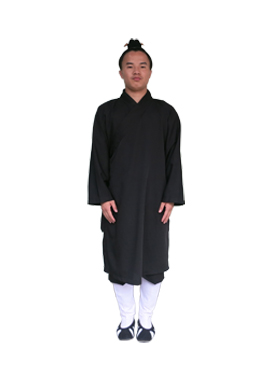
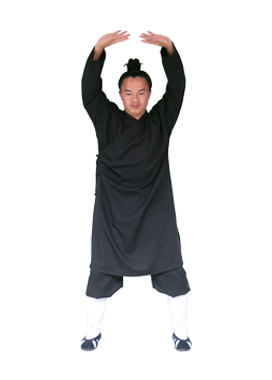
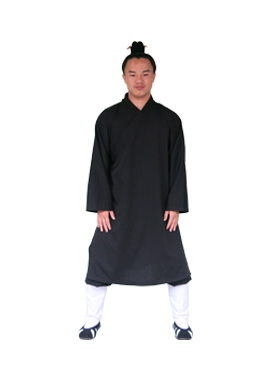
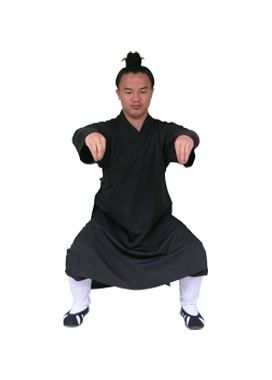
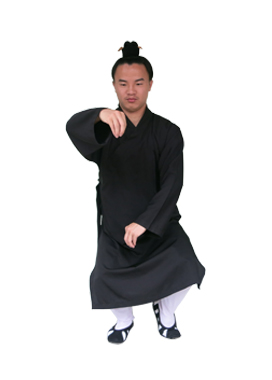
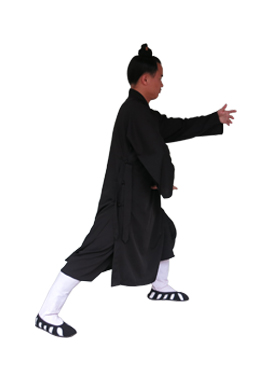 .
.